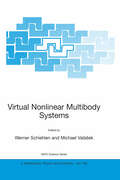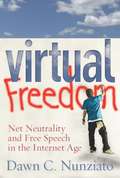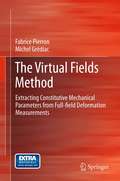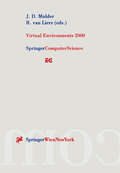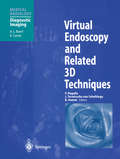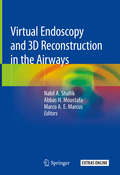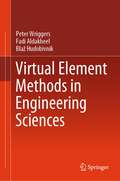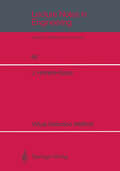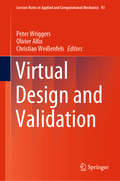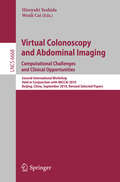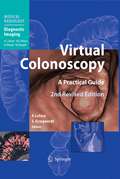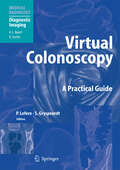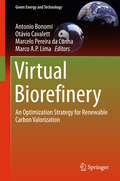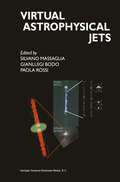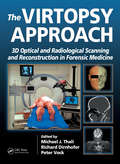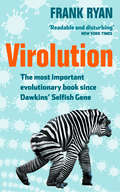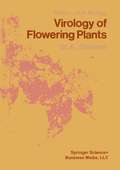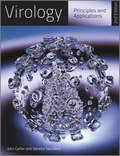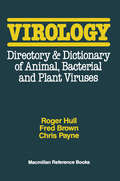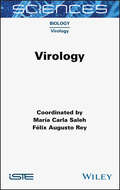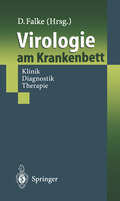- Table View
- List View
Virtual Nonlinear Multibody Systems (NATO Science Series II: Mathematics, Physics and Chemistry #103)
by Werner Schiehlen Michael ValásekThis book contains an edited versIOn of lectures presented at the NATO ADVANCED STUDY INSTITUTE on VIRTUAL NONLINEAR MUL TIBODY SYSTEMS which was held in Prague, Czech Republic, from 23 June to 3 July 2002. It was organized by the Department of Mechanics, Faculty of Mechanical Engineering, Czech Technical University in Prague, in cooperation with the Institute B of Mechanics, University of Stuttgart, Germany. The ADVANCED STUDY INSTITUTE addressed the state of the art in multibody dynamics placing special emphasis on nonlinear systems, virtual reality, and control design as required in mechatronics and its corresponding applications. Eighty-six participants from twenty-two countries representing academia, industry, government and research institutions attended the meeting. The high qualification of the participants contributed greatly to the success of the ADVANCED STUDY INSTITUTE in that it promoted the exchange of experience between leading scientists and young scholars, and encouraged discussions to generate new ideas and to define directions of research and future developments. The full program of the ADVANCED STUDY INSTITUTE included also contributed presentations made by participants where different topics were explored, among them: Such topics include: nonholonomic systems; flexible multibody systems; contact, impact and collision; numerical methods of differential-algebraical equations; simulation approaches; virtual modelling; mechatronic design; control; biomechanics; space structures and vehicle dynamics. These presentations have been reviewed and a selection will be published in this volume, and in special issues of the journals Multibody System Dynamics and Mechanics of Structures and Machines.
Virtual Image in a Plane Mirror (UEB uncontracted)
by RnibThis labelled image shows two eyes looking at the reflection of a nose in a mirror. There is a locator dot shown, which will be at the top left of the page when the image is the correct way up. The eyes and nose are on the centre left of the page. Two rays of light are shown diverging right from the round shape of the nose. They hit the surface of the mirror and are reflected to the left, with one ray going to each eye. Follow the reflected rays back to the right through the mirror to where they converge. The eyes will see a virtual image of the nose that seems to be the same distance behind the mirror as the real one is in front of it.
Virtual Image in a Plane Mirror (UEB contracted)
by RnibThis labelled image shows two eyes looking at the reflection of a nose in a mirror. There is a locator dot shown, which will be at the top left of the page when the image is the correct way up. The eyes and nose are on the centre left of the page. Two rays of light are shown diverging right from the round shape of the nose. They hit the surface of the mirror and are reflected to the left, with one ray going to each eye. Follow the reflected rays back to the right through the mirror to where they converge. The eyes will see a virtual image of the nose that seems to be the same distance behind the mirror as the real one is in front of it.
Virtual Image in a Plane Mirror (large print)
by RnibThis labelled image shows two eyes looking at the reflection of a nose in a mirror. There is a locator dot shown, which will be at the top left of the page when the image is the correct way up. The eyes and nose are on the centre left of the page. Two rays of light are shown diverging right from the round shape of the nose. They hit the surface of the mirror and are reflected to the left, with one ray going to each eye. Follow the reflected rays back to the right through the mirror to where they converge. The eyes will see a virtual image of the nose that seems to be the same distance behind the mirror as the real one is in front of it.
Virtual Freedom: Net Neutrality and Free Speech in the Internet Age
by Dawn C. NunziatoCommunications giants like Google, Comcast, and AT&T enjoy increasingly unchecked control over speech. As providers of broadband access and Internet search engines, they can control online expression. Their online content restrictions—from obstructing e-mail to censoring cablecasts—are considered legal because of recent changes in free speech law. In this book, Dawn Nunziato criticizes recent changes in free speech law in which only the government need refrain from censoring speech, while companies are permitted to self-regulate. By enabling Internet providers to exercise control over content, the Supreme Court and the FCC have failed to protect the public's right to access a broad diversity of content. Nunziato argues that regulation is necessary to ensure the free flow of information and to render the First Amendment meaningful in the twenty-first century. This book offers an urgent call to action, recommending immediate steps to preserve our free speech rights online.
The Virtual Fields Method: Extracting Constitutive Mechanical Parameters from Full-field Deformation Measurements
by Fabrice Pierron Michel GrédiacThe Virtual Fields Method: Extracting Constitutive Mechanical Parameters from Full-field Deformation Measurements is the first and only one on the Virtual Fields Method, a recent technique to identify materials mechanical properties from full-field measurements. It contains an extensive theoretical description of the method as well as numerous examples of application to a wide range of materials (composites, metals, welds, biomaterials etc.) and situations(static, vibration, high strain rate etc.). Finally, it contains a detailed training section with examples of progressive difficulty to lead the reader to program the VFM. This is accompanied with a set of commented Matlab programs as well as with a GUI Matlab based software for more general situations.
Virtual Environments 2000: Proceedings of the Eurographics Workshop in Amsterdam, The Netherlands, June 1–2, 2000 (Eurographics)
by J. D. Mulder R. Van LiereThis book contains the proceedings of the sixth Eurographics Workshop on Vir tual Environments. The event took place from June 1 to June 2, 2000, in Am sterdam. We hope that readers will find these proceedings to be valuable, not only for virtual environment researchers, but also for practitioners developing or using virtual environment applications. We are glad to report that visibility of the workshop continues to expand and that virtual environment researchers and practitioners from allover the world are submitting papers. This year, 40 papers and case studies were submitted of which 20 were accepted. In addition, we are glad to see that the focus of the workshop is also expanding. We accepted 6 research papers on evaluation of virtual environments and there was a broad sampling of other topics. We would like to thank all those involved in organizing the symposium. In particular, thanks go to Mieke Brune who was in charge of the local organization. In addition, we want to thank the international program committee for their excellent, yet laborious, job in reviewing all submitted papers. The quality of the workshop is a reflection of the quality of the submitted papers and the quality of the reviewing process.
Virtual Endoscopy and Related 3D Techniques (Medical Radiology)
by A. L. Baert P. Rogalla A. J. Aschoff C. I. Bartram J. Terwisscha van Scheltinga B. Hamm T. R. Fleiter S. Gottschalk R. Klingebiel N Meiri E. M. Merkle T. H. Wiese C. WisianowskyVirtual endoscopy is a valuable independent diagnostic tool of increasing importance. This book provides an in-depth evaluation of the technical aspects of virtual endoscopy, and detailed information on indications, implementation, and interpretation in a clinical setting. It is designed to support radiologists and educators in approaching this rapidly developing field. It will also assist consumers in judging the applicability of software and hardware packages for virtual endoscopy, and will benefit producers by highlighting current limitations and potential improvements from a clinical viewpoint.
Virtual Endoscopy and 3D Reconstruction in the Airways
by Nabil A. Shallik Abbas H. Moustafa Marco A. E. MarcusThis book is unique in its approach, covering the impact of virtual endoscopy and 3D reconstruction on surgical modalities and perioperative airway options. Airway management is an essential skill that is practiced daily by almost all anesthetists across the world. Most of the anesthesia-related morbidities and mortalities in the perioperative period are associated with respiratory complications, either of airway or pulmonary problems. Thus, the prediction of airway complications in perioperative period has been an active research field for many decades and is a cornerstone of perioperative anesthesia assessment and management.Virtual endoscopy & 3D reconstruction is a novel, reliable and non-invasive airway assessment tool that is able to reconstruct simple CT images to provide a clear view of the airway down to the bronchial trees, and offers the highest possible sensitivity, comparable with fiberoptic endoscopic pictures. This revolutionary tool avoids the hazards of invasive airway assessment by fiber-optic bronchoscopy, like bleeding from airway masses, sedation induced airway collapse and other complications. This book is a valuable resource for anesthesiologists, intensivists, surgeons, radiologists, otolaryngologists, medical students as well as residents in training.
Virtual Element Methods in Engineering Sciences
by Peter Wriggers Fadi Aldakheel Blaž HudobivnikThis book provides a comprehensive treatment of the virtual element method (VEM) for engineering applications, focusing on its application in solid mechanics. Starting with a continuum mechanics background, the book establishes the necessary foundation for understanding the subsequent chapters. It then delves into the VEM's Ansatz functions and projection techniques, both for solids and the Poisson equation, which are fundamental to the method. The book explores the virtual element formulation for elasticity problems, offering insights into its advantages and capabilities. Moving beyond elasticity, the VEM is extended to problems in dynamics, enabling the analysis of dynamic systems with accuracy and efficiency. The book also covers the virtual element formulation for finite plasticity, providing a framework for simulating the behavior of materials undergoing plastic deformation. Furthermore, the VEM is applied to thermo-mechanical problems, where it allows for the investigation of coupled thermal and mechanical effects. The book dedicates a significant portion to the virtual elements for fracture processes, presenting techniques to model and analyze fractures in engineering structures. It also addresses contact problems, showcasing the VEM's effectiveness in dealing with contact phenomena. The virtual element method's versatility is further demonstrated through its application in homogenization, offering a means to understand the effective behavior of composite materials and heterogeneous structures. Finally, the book concludes with the virtual elements for beams and plates, exploring their application in these specific structural elements. Throughout the book, the authors emphasize the advantages of the virtual element method over traditional finite element discretization schemes, highlighting its accuracy, flexibility, and computational efficiency in various engineering contexts.
Virtual Design and Validation (Lecture Notes in Applied and Computational Mechanics #93)
by Peter Wriggers Olivier Allix Christian WeißenfelsThis book provides an overview of the experimental characterization of materials and their numerical modeling, as well as the development of new computational methods for virtual design. Its 17 contributions are divided into four main sections: experiments and virtual design, composites, fractures and fatigue, and uncertainty quantification. The first section explores new experimental methods that can be used to more accurately characterize material behavior. Furthermore, it presents a combined experimental and numerical approach to optimizing the properties of a structure, as well as new developments in the field of computational methods for virtual design. In turn, the second section is dedicated to experimental and numerical investigations of composites, with a special focus on the modeling of failure modes and the optimization of these materials. Since fatigue also includes wear due to frictional contact and aging of elastomers, new numerical schemes in the field of crack modeling and fatigue prediction are also discussed. The input parameters of a classical numerical simulation represent mean values of actual observations, though certain deviations arise: to illustrate the uncertainties of parameters used in calculations, the book’s final section presents new and efficient approaches to uncertainty quantification.
Virtual Colonoscopy and Abdominal Imaging: Second International Workshop, Held in Conjunction with MICCAI 2010, Beijing, China, September 20, 2010, Revised Selected Papers (Lecture Notes in Computer Science #6668)
by Hiroyuki Yoshida Wenli CaiThis book constitutes the thoroughly refereed post-conference proceedings of the International Workshop on Computational Challenges and Clinical Opportunities in Virtual Colonoscopy and Abdominal Imaging, held in conjunction with MICCAI 2010, in Beijing, China, on September 20, 2010. The 19 revised full papers presented were carefully reviewed and selected from 26 submissions. The papers are organized in topical sections on CT colonography CAD, abdominal imaging, and virtual colonoscopy.
Virtual Colonoscopy: A Practical Guide (Medical Radiology)
by Y. Arai D. Bielen F. Booya D. Burling F. Cerri A. H. Dachman A. H. Vries H. Fenlon J. G. Fletcher S. Gryspeerdt L. S. Guimaraes S. Halligan G. Iinuma A. Laghi P. Lefere A. Maier T. Mang B. G. McFarland R. Mendelson M. Miyake N. Moriyama K. J. Mortelé Y. Muramatsu D. Murphy E. Neri P. R. Obara A. S. Odulate M. Raquel Oliva P. Pokieser W. Schima J. Stoker S. A. Taylor F. Turini K. Uchida J. Yee H. Yoshida M. E. ZalisPhilippe Lefere Stefaan Gryspeerdt A. L. BaertRapid progress in the technique and practice of virtual colonoscopy as well as the conti- ing clinical high interest for this radiodiagnostic procedure made this second edition, only 3 years after the publication of the ? rst edition of this successful volume, necessary. This new edition includes the latest study results and technical developments of this exciting noninvasive diagnostic modality for the evaluation of the colon. The technical presentation and lay out of the text and of the many new illustrations are impeccable. The editors were again able to ensure the collaboration of many international leaders in the ? eld and the book offers a very comprehensive overview of all aspects and issues of CT colonography with a focus on how to perform practically this examination, which requires meticulous technique starting from rigorous preparation, then the conduct of the study itself, and ? nally the interpretation of the results. I am very much indebted to the editors and the collaborating authors for preparing this outstanding volume in a record short time period, which enabled them to include the latest technical advances in this rapidly evolving important radiological method. It is highly recommended to general and gastrointestinal radiologists as well as gast- eneterologists as a most welcome update of their knowledge and as a practical guide in their daily practice. I am convinced that this second edition will meet the same success with our readership as the ? rst one.
Virtual Colonoscopy: A Practical Guide (Medical Radiology)
by Philippe Lefere A. L. Baert Stefàan GryspeerdtVirtual colonoscopy, or CT colonography, is a novel and rapidly evolving technique for the detection of tumoral lesions in the colon. It promises to be of great value as a screening tool for both colorectal cancer and its adenomatous precursor. With contributions from several leaders in the field, this book addresses all the important issues relating to virtual colonoscopy. There is a particular focus on practical aspects: how to start virtual colonoscopy in a department, the regular preparation, the importance of fecal tagging, how to reduce the preparation, how to obtain optimal colonic distension, and the correct scanning parameters. Imaging characteristics and pitfalls are considered in detail, with an extensive pictorial review of difficult lesions, and the importance of computer-aided diagnosis is discussed. This book will be invaluable to every radiologist seeking information on how to perform the exciting technique of virtual colonoscopy.
Virtual Biorefinery: An Optimization Strategy for Renewable Carbon Valorization (Green Energy and Technology)
by Antonio Bonomi Otavio Cavalett Marcelo Pereira da Cunha Marco A. P. LimaThis book presents a concise framework for assessing technical and sustainability impacts of existing biorefineries and provides a possible road map for development of novel biorefineries. It offers a detailed, integrated approach to evaluate the entire biomass production chain, from the agricultural feedstock production and transportation, to the industrial conversion and commercialization & use of products. The Brazilian sugarcane biorefinery is used as a case study; however, the methods and concepts can be applied to almost any biomass alternative. Chapters explore the main issues regarding biorefinery assessment, including feedstock production and transportation modeling, biofuels and green chemistry products, as well as assessment of sustainability impacts. This book is a valuable source of information to researchers in bioenergy, green chemistry and sustainability fields. It also provides a useful framework for government agencies, investors and the energy industry to evaluate and predict the success of current and future biorefinery alternatives.
Virtual Astrophysical Jets: Theory Versus Observations
by Silvano Massaglia Gianluigi Bodo P. RossiThese proceedings are the result of a three-day meeting held in Oogliani (Italy), on October 2-4 2003, whose title was "VIrtual Astrophysical Jets 2003". Our goal in convening this meeting was to gather some of the scientists among the most active in the field of numerical simulations and modelling of astrophysi cal jets. For keeping the participants close to the "real world", we also invited a few observers to give up-to-date reviews outlining the state-of-the-art of jet observations. The principal aim of the meeting was thus to present and critically discuss the state-of-the-art numerical simulations, analytical models and laboratory ex periments for reproducing the main aspects of astrophysical jets and compar ing them with observations. The discussion has been focused on the following topics: • Observations and intepretions of jets from young stars and AGNs, comparisons of models with observations; • MHO accelerations of jets: steady self-similar models, MHO numerical simula tions of time-dependent accelerations mechanisms; • Jet stability and interaction with the ambient: formation of knots in YSO jets, jet survival to instabilities, deceleration of relativistic jets in FRI sources, simulations of jets-IGM interactions, jets propagation and galaxy formation; • Numerical codes and their validation: relativistic MHO codes, comparisons among different numerical schemes, jets in the laboratory and code validation. These topics have been discussed intensively during the meeting, and the out come of these discussions is presented in this volume. The contributions have been divided in five sections.
The Virtopsy Approach: 3D Optical and Radiological Scanning and Reconstruction in Forensic Medicine
by Michael J. Thali Richard Dirnhofer Peter VockCharred, badly decomposed, or mummified corpses, as well as those restrictions forced upon coroners by certain religious sects, often make autopsies impossible to perform. In addition, lack of manpower among the personnel charged with performing autopsies frequently creates a backlog of cases in the coroner‘s office. This delay increases the likeli
Virolution: Die Macht Der Viren In Der Evolution
by Frank RyanThe extraordinary role of viruses in evolution and how this is revolutionising biology and medicine.
Virology: Principles and Applications
by John Carter Venetia SaundersThe second edition of Virology is an accessible introduction designed to enable students to understand the principles of virus structure, replication and genetics. The aim of this book is to help the reader appreciate the relevance of virology in the modern world, including the fields of vaccines, anti-viral drugs and cancer. There is also a chapter on prions. The second edition has been extensively revised and updated to reflect the many developments in virology and offers deeper insights into the subject. Newly-discovered viruses are discussed and there is an additional chapter on the influenza virus.
Virology: A Directory and Dictionary of Animal, Bacterial and Plant Viruses
by Roger Hull Fred Brown Chris PayneA comprehensive dictionary describing all known viruses of animal and plants. It describes terms commonly used in virology as well as cell lines and chemicals used in organizations and the techniques applied in this work. Equations, formulae and definitions of units in virology are covered.
Virology
by Maria Carla Saleh Felix Augusto ReyViruses interact with all forms of life and have shaped evolution for 4 billion years. The COVID-19 pandemic highlights the importance of conducting scientific research into viruses to understand the interactions between them and their hosts. Virology is made up of eight chapters, all of which have been written by outstanding female virologists, emphasizing women's fundamental role in all aspects of science. It summarizes our current knowledge about the biology of viruses in general and analyzes the specific features of several ones of medical, veterinary and agricultural importance. Genome replication strategies of different virus families are covered, as well as strategies for survival within their hosts by counteraction of the cellular innate antiviral responses. Attention is also given to viral strategies for efficient dissemination in nature, as well as the evolution of a select group of viruses.
Virology
by Maria Carla Saleh Felix Augusto ReyViruses interact with all forms of life and have shaped evolution for 4 billion years. The COVID-19 pandemic highlights the importance of conducting scientific research into viruses to understand the interactions between them and their hosts. Virology is made up of eight chapters, all of which have been written by outstanding female virologists, emphasizing women's fundamental role in all aspects of science. It summarizes our current knowledge about the biology of viruses in general and analyzes the specific features of several ones of medical, veterinary and agricultural importance. Genome replication strategies of different virus families are covered, as well as strategies for survival within their hosts by counteraction of the cellular innate antiviral responses. Attention is also given to viral strategies for efficient dissemination in nature, as well as the evolution of a select group of viruses.
Virologie am Krankenbett: Klinik, Diagnostik, Therapie
by J. Bohl R. W. Braun H. P. Dienes D. Falke G. Gerken B. Jansen K. M. Keller J. PodlechDas erste Kitteltaschenbuch für die praktisch-klinische Medizin! Prägnant werden alle wichtigen Viruskrankheiten beschrieben. Klare Einführungen, farbige Abbildungen und differentialdiagnostische Tafeln erschließen die Praxis-Informationen auf einen Blick. Eine Übersicht zur allgemeinen Virologie, Chemotherapie und Hygiene rundet den Inhalt ab.
